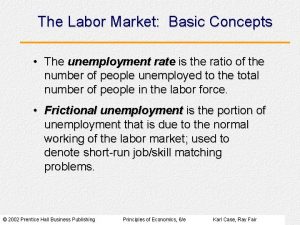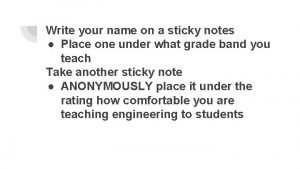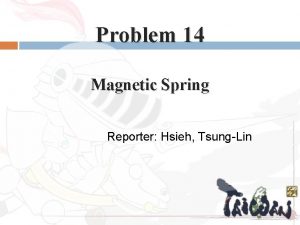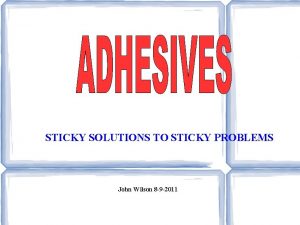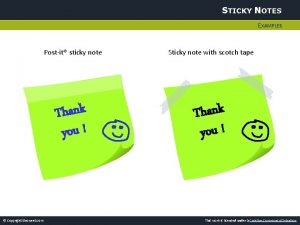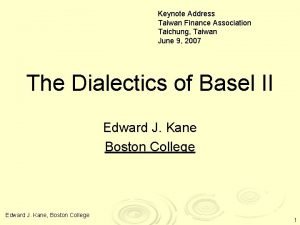Sticky Water Taiwan Hsieh TsungLin Question When a























- Slides: 23

Sticky Water Taiwan Hsieh, Tsung-Lin

Question When a horizontal cylinder is placed in a vertical stream of water, the stream can follow the cylinder's circumference along the bottom and continue up the other side before it detaches. Explain this phenomenon and investigate the relevant parameters.

Coanda Effect The tendency for a fluid jet to be attracted to a nearby surface. Theoretical explanation is difficult because we have to deal with fluid mechanics, not particle mechanics.

A Simple Argument From a book “Fluid Dynamics for Physicists” by T. E. Faber, we have a simple argument but not realistic. 2 -d flow (the 3 rd dimension is infinite) A perfect imcompressible fluid (No viscosity, no vorticity) No gravity Conservation of energy Conservation of tangential momentum

At the impact point, tangential momentum is conserved, so the backward jet is thinner, less mass. The two jets move half a circle in equal time and collide again. The jet detaches because of collision.

Some Subtle Differences We should consider Adhesive force Cohesive force Gravity Viscosity Vorticity The cross section of the jet will be subjected to a free surface boundary condition by the air pressure and the cylinder.

Experimental Setup Water tank Faucet Cylinder Reservoir

Experimental Setup Front view Side view

At the impact point Water spread out in every direction. There is more momentum (mv) in the forward direction. Water flow

Spreading Out The water jet flows down due to gravity. The velocity will be different at different point. Wetting Surface tension

Convergence The stream converges because: The velocity is greater, Evidently, the cohesion wins over the wetting. Wetting Surface tension

Instability Convergence results in instability. Do not necessary flows tangentially.

Detachment • Fluid instability results in detachment.

Parameters Initial speed at the point of impact- 220, 200, 170, 150 cm/s Cylinder material- acrylic, steel, wax paper Impact angle- 20~75 deg Cylinder diameter Faucet bore diameter

Definitions

Water Speed

Impact Angle

Cylinder Diameter

Cylinder Material

Side Width- Initial Speed Higher velocity, larger is the spread. Water spreads wider on acrylic cylinder. Maximum width

Summary The “sticky water” effect is real. The leaving angle have large error due to instability of the stream. No significant relation is found. Stream spreads out when the speed is higher, and wider on acrylic cylinder.

Reference Fluid Dynamics for Physicists by T. E. Faber Flying Circus of Physics by … Teapot effect Halliday…

Thank you!
 Water and water and water water
Water and water and water water Ellen hsieh
Ellen hsieh Chung-yun hsieh
Chung-yun hsieh Tertiary line of the ikebana representing earth
Tertiary line of the ikebana representing earth Wilson hsieh
Wilson hsieh Kim hsieh
Kim hsieh Dr christine hsieh
Dr christine hsieh Question question question
Question question question Manager or supervisor higher
Manager or supervisor higher Sticky wages
Sticky wages Sticky wages
Sticky wages Sticky tape lab
Sticky tape lab Sticky tape lab answers
Sticky tape lab answers Example of sticky information
Example of sticky information A sticky adventure! ?✨
A sticky adventure! ?✨ Classification of inlay wax
Classification of inlay wax Sticky wages
Sticky wages Suiteworld 2018 agenda
Suiteworld 2018 agenda Sticky notes name
Sticky notes name Sticky notes developers
Sticky notes developers Chemistry unit 6 sticky tape post lab
Chemistry unit 6 sticky tape post lab Send sticky broadcast
Send sticky broadcast Sticky tape experiment
Sticky tape experiment Inlay wax types
Inlay wax types










